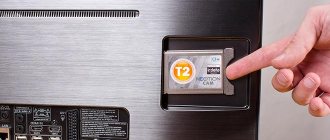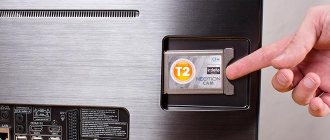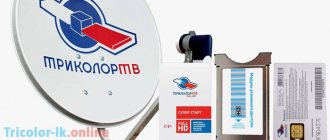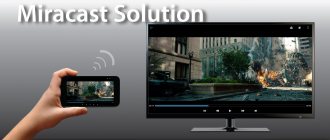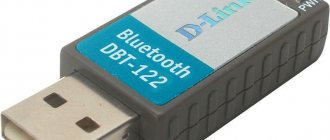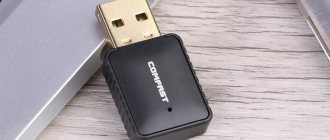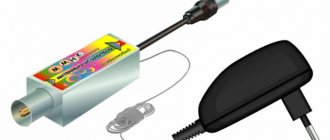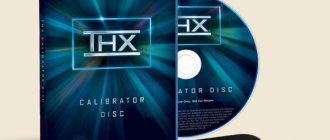To watch free digital channels, you need special equipment - a DVB T2 tuner. It acts as a kind of intermediary between the antenna and the TV, decoding the incoming signal. If there is a need for paid channels, providers offer the purchase of a set-top box, which, in addition to decoding the signal, includes a set of codes for accessing restricted content. But there is also a third, less troublesome option that eliminates bulky third-party peripherals - a cam module for a TV. Let's figure out what it is, what types of devices are found, and how to connect it.
Content
Modern TVs are designed so that the owner gets maximum access to different signal sources with a minimum of additional funds. It is inconvenient for the user, for example, to control a separate satellite tuner or set-top box for receiving digital cable television channels. It’s much easier when there are no additional devices, because everything is built into the TV and controlled from one remote control. This is implemented in modern TV models. But it is necessary to resolve the issue of restricting access to content to ensure intellectual property rights. Companies providing content solve it using CAM modules and CI.
Operating principle of CAM
The module reads only original smart cards. They are usually issued by the provider. You can connect the module to the TV either through a common interface (CI port) or using a 5-volt CI adapter. The latter in a good half of cases comes complete with TV equipment, or is purchased separately in specialized stores.
A TV with a CAM module and an original card inside is identified on the provider’s servers and the user is given access to both free and paid channels. Such equipment significantly facilitates the TV broadcasting procedure and has a number of advantages.
Advantages of the CAM module:
- there is no need to connect third-party expensive receivers;
- easy installation of the CAM module into the TV;
- reception of not only paid, but also free-to-air channels;
- all functionality is available from the control panel.
What is CI and CAM module
CI (Common Interface) is a slot located on the back of the TV. May also be called PCMCIA connector. Common Interface is a system that provides the device owner with access to encrypted content. Basically, the content is provided by TV channels, but access, for example, to a database of films and animations can be provided.
"CAM" stands for "Conditional Access Module". The CAM module is inserted into the CI slot. A decoding smart card from the content provider (cable or satellite television provider) is placed in the CAM module. Without it, the CAM module will not work, since all the information necessary for decryption is located on the card and is read from it during operation. Essentially, a CAM module is an adapter for an access card to the provider’s licensed/paid content. The smart card contains a microchip. It provides identification of a specific subscriber in the operator’s network and unlocks content in accordance with the tariff plan.
The CAM module is usually included with the TV. If for some reason it is not there, but there is a CI slot, then the module will have to be purchased separately. Alternatively, content providers provide CAM modules along with the service. It is usually offered for rent for little money.
How to connect a smart card
To connect the CAM module, you need to perform a number of simple steps. First, insert the smart card into the adapter with the chip facing up, holding the device with the front panel facing you. Then the module charged with the card is inserted into the television connector with the front side facing out. After this, you need to turn on the TV and go through the main access menu to automatically search for channels.
The advantages of the CAM module are obvious.
- Price. Depending on the type of adapter, the purchase price varies in the range of 1500 – 6000 rubles.
- Easy connection. No cable, connecting interfaces, additional power point or space for module placement is required.
- Control your TV with one remote control.
Of the minuses: the solution is only suitable for TV receivers that support digital formats DVB-S and DVB-S2 and are equipped with a PCMCIA slot.
How does decoding work?
Providers of digital content - cable television or satellite channels - transmit it in encrypted form. In order to unblock the signal of encrypted channels, you need a code that is changed by the provider according to a certain algorithm.
This code is transmitted via the CAM module from the decoding smart card issued by the provider to the tuner. As a result, those channels that are paid and included in the tariff plan will be unblocked, while others will remain closed. When changing the tariff plan, the provider remotely changes the codes on the smart card, opening or closing channels to the user.
This way you can unblock digital cable or satellite TV channels.
In order to have something to unlock, the TV must be equipped with the appropriate tuners. Reception of cable television signals is carried out using tuners - DVB-C or DVB-C2, and satellite - DVB-S or DVB-S2. Also, to receive satellite television, you must have an antenna that receives the signal from the satellite. The cable TV provider will transmit via cable.
What is a Tricolor TV conditional access module?
This device is considered a kind of receiver that is directly connected to the TV. Its design consists of two blocks - a compact module for processing information and a smart card, which opens access to the world of satellite television Tricolor TV. No other additional elements are required anymore. The size of the device is comparable to a card. Moreover, after connecting it to the TV, the equipment will be completely invisible, and nothing will interfere with the interior of the room. To ensure that the installation of the conditional access module goes without any difficulties, carefully read the instructions. If installed incorrectly, satellite TV will not be available.
Why CI and CAM module are more convenient
The main advantage of using CI and CAM modules built into the TV is that it reduces the amount of equipment used. You don't need a set-top box for digital cable channels or a separate tuner for satellite TV. Let's list the positive points:
- The amount of equipment is reduced, it does not take up space.
- There is no need for an extra outlet to connect a tuner or set-top box.
- Only one control panel is used, and not two, as is the case with the set-top box.
- There is no need for additional cables to connect the tuner/set-top box to the TV. There are no additional nodes and blocks that can affect the quality of image and sound.
- There is no need to spend extra money on purchasing equipment.
- Easy to set up and connect.
Fundamental differences between the receiver
The satellite TV set-top box can be used with any TV receiver: modern or one that has served for more than 10 years . Depending on the model of the receiver, in addition to the main function - decoding a digital signal - it can also perform a number of other functions.
To connect an external device to watch satellite TV you will need:
- shielded cable with a special connector (from the dish to the receiver);
- interface connecting the set-top box to the TV;
- network cable for powering the decoder.
The number and quality of viewing received channels depends on the hardware and software of the receiver.
Satellite receivers can be single-system with firmware customized for a specific provider. Tuners with Internet access (for card sharing) and receivers for receiving open broadcast channels are also in demand.
Satellite receiver Openbox SX6 HD
Let's look at the main advantages of the receiver.
- The device is more convenient in terms of working with channels. The user can sort TV channels at his own discretion, search for content in manual and automatic modes.
- There is a convenient teletext service: you can view annotations for program schedules and programs of your favorite channels for the current and next day.
- Availability of access to interactive television channels (the ability to select a program and time to watch it). For example, the provider Tricolor has 10 cinemas broadcasting films.
- If there are TV receivers in different rooms in the house with connected cables from a satellite dish, then the only receiver can be moved mobile from one room to another.
- Most receivers are equipped with a small screen that displays the current time and number of the channel being viewed.
Among the disadvantages, first of all, it is necessary to note the price. The cost of the simplest receiver is 20-30% more expensive than a universal CAM module. In addition, there will be costs for the cable necessary for installing the equipment and payment for the services of a specialist (if a specialist is involved in the connection).
TV viewing has to be controlled from two remote controls, which is not very convenient. The TV remote control turns on the TV, adjusts the volume, and to change channels you need to use the remote control from the set-top box. Although now there are modern models of set-top boxes that support control with one remote control.
Types of CAM modules and CI
Depending on the version, CI can support the installation of one or two access cards. Why might this be needed? For example, if you want to receive content from two providers. Now, in addition to CI, there is CI+. This is an updated version of the system with an increased degree of protection against piracy. CI+ implements such options for the operator as a ban on recording programs, permission to view media content once, or a ban on advertising.
CAM modules come in two types:
- single-system
- universal
Single-system modules can only work with one specific type of encoding. Usually content providers supply them along with a smart card when concluding a contract. Therefore, when changing providers, you will need another module that provides signal decoding in another network.
Universal modules support several encoding algorithms. In this case, cards from different operator providers can be installed in the CAM module. The device will automatically determine which decoding algorithm to use in a particular case. If you have a universal module, it is enough to obtain only a smart card from the provider.
Types of CAM modules
On the market of devices for TV equipment you can find several varieties of such modules. They differ both in functionality and technical parameters. The choice of one or another CAM module depends on the user’s ultimate goals.
Single channel devices
These are the simplest, and at the same time inexpensive modules. Such devices allow you to decode only one system, for example, Tricolor or NTV+. In a good half of cases, a smart card is not required here, because all the necessary data is already embedded in the body of the module.
Important! The only significant drawback of such devices is their single-channel nature. You cannot change the decoding system here. That is, if the module is flashed to Tricolor, then it will not work with another provider and will simply become useless when changing service providers.
T2
This is another type of single-channel devices. Its purchase will also cost a pittance, but you will have to pay for the cheapness with versatility. The CAM module in a T2 format TV can receive a digital signal, which is broadcast only live.
A smart card is also not needed here, because all decoding data is sewn into the device body. Changing code algorithms and keys is not provided, so if you change the provider, you will have to abandon the existing CAM module.
Multichannel devices
These are multifunctional modules that can work with almost any smart card. If you insert such a module into TV equipment, it will automatically adapt to the existing encoding system and organize the broadcast of channels.
More expensive devices are designed to simultaneously receive different providers and satellites. For example, the widely popular PowerCam Pro station wagon is able to decode up to 12 services and, accordingly, the same number of smart cards.
Universal devices
Such CAM modules independently decode any systems and smart cards. Such devices are capable of changing basic broadcast parameters and configuring related software. For the sake of security, many TV service providers constantly change encoding systems, and with them CAM modules.
In the case of a universal device, any user intervention is excluded: the module itself will adapt to new algorithms. Naturally, its cost is noticeably higher than that of previous options.
What other devices are equipped with CI slots?
In addition to televisions, receivers for receiving satellite television and some set-top boxes for receiving digital and cable television are equipped with CI and CI+ slots. At the same time, slots for the CAM module are available in set-top box models that are comparable in price to a TV. Inexpensive models usually do not have such slots.
As a result, the user of a set-top box equipped with a DVB-C tuner, but without a CI slot, will not be able to watch all cable television channels, since they are encoded by the provider. If the CAM module is missing, only a limited range of broadcasts will be available that are not encrypted by the provider. Be sure to consider this point when planning your purchase and connecting to media content providers.
Which connection option to use?
It should be noted that satellite equipment must be selected according to the technical conditions and preferences of the user. If there is a modern TV in the house, the household members are satisfied with the minimalism of the functions, and there is no desire to use two remote controls to control TV viewing, then, having decided on the provider, purchase a CAM module with a card. If your existing television receiver does not support satellite television broadcasting, then you cannot do without a receiver. The set-top box is also chosen by those users of modern TV receivers who are interested in the additional functionality of the receivers.
Sam terminal module what is it?
Microcrypt Technologies Ltd.
- home
- Company
- Services
- Products
- Portfolio
- Career
- Hardware
- Software
- Complexes
SAM Hierarchy
An integral element of modern smart card servicing systems in off-line mode, i.e.
without connecting to some central authentication server, are “hardware security modules” (HSM - Hardware Security Module) or SAM modules (Security Access Modules). Their main task is the secure storage and use of secret keys used to conduct transactions with the user’s card. In addition to protecting key information, the security module can also ensure the transactional nature of the card exchange protocol and the secure accumulation and storage of data on completed transactions (this functionality is determined by the specific scope of the security module). In general, the use of SAM modules allows you to protect against two serious security threats: card cloning and “stuffing” unauthorized transactions into the system. “SAM Hierarchy” is a hierarchical system of SAM modules designed to support the full life cycle of smart cards (or tokens): from issuance and maintenance, to destruction or reinitialization. This system allows for the secure generation, distribution, storage and use of secret keys used to work with user cards. The hierarchy of SAM modules includes three classes of devices with different functional purposes:
- Root – generate secret keys for the entire hierarchy of SAM modules, i.e. in fact, its creation;
- Master – used for backup storage and initialization of Service devices;
- Service – used directly for initializing and servicing user cards.
This division of the hierarchy into device classes allows you to separate the functional “roles” of devices, and, accordingly, protect against key compromise due to inappropriate use of SAM modules. The threat of inappropriate use arises when SAM modules are used in an “uncontrolled” territory. The use of Root and Master devices, as a rule, can be limited to one protected room of the IT security department, while Service devices should be used as part of geographically distributed POS terminals. Therefore, the device role determines whether private keys can be exported:
- Root – can generate and export keys to Master devices;
- Master – can import keys from Root and Master devices, as well as export to other Master and Service devices;
- Service – can only import key information and use it to perform the corresponding business function.
How to connect the module
Any user can figure out the installation and configuration; there is nothing complicated; it is quite possible to do without the help of third-party specialists. To install everything correctly, you must proceed as follows:
- Carefully insert the smart card. To do this, take the CAM module in your hands and turn it towards you with the title side. We insert the card with the contacts facing up, and check that it is completely seated. If you do everything correctly, you will no longer need to figure out how to install a smart card.
- We insert the module into the TV. There is a special slot for this, located on the back of the device. The module is installed on a certain side.
Before figuring out how to set up Tricolor TV channels, make sure that the TV sees the connected module. To do this, go to the settings and check the information about the connected CAM module. If there is no information about it, check that it is installed correctly.
Setting up channels
At the moment, the conditional configuration algorithm is as follows:
- open the menu using the corresponding key on the remote control;
- select the channel search option (automatic mode);
- in the search settings set “Satellite”;
- in the list that opens, select Tricolor;
- start the search;
- the procedure takes a few minutes;
- all channels of the Tricolor operator will be displayed;
- save the changes.
Depending on your TV model, there may be some minor changes in settings.
Possible difficulties during the connection process
Despite the apparent ease of connection, users have difficulty connecting. Thus, a common problem is docking the module with a smart TV. Although most often many cannot figure out the settings. In comparison with the receiver, the menu is limited to literally a few positions, which significantly reduces the space for maneuvers. Other problems are also quite possible. All difficulties can be resolved quickly if you contact TV support specialists. They will tell you in detail how to properly configure and install the module in your TV.
Video instruction
Setting up equipment on TVs with a CI+ connector. Registration, connection and configuration of the module, assembly and installation of the antenna, adjusting the signal level and searching for channels.
In conclusion
Having figured out what the Tricolor conditional access module is and having chosen a suitable TV, all that remains is to connect everything correctly and accurately. Having activated the subscription, we wait for the broadcast to start. The undoubted advantage of such a connection is the absence of additional wires and control by one control panel.
Smart Roadster › Logbook › SAM module as a source of glitches
The long battle with incomprehensible glitches in the car is over. I’ll say right away: there are already a lot of articles, manuals, and forum threads written on this topic, but I’m writing in order to speak out and make troubleshooting easier for one of the smart drivers. SO: Even before it had been sitting in the garage for a long time, in 2012, rare but intrusive “single-line dashes” began to appear on the indicator. Any, even quick, Internet browsing clearly indicates that this is an error on the CAN bus. Catching such a rare, but neatly appearing, floating error is a hemorrhoids task because all the computers on the machine are connected by this bus. The appearance of the error increased as the temperature increased and the vehicle warmed up. As a result: either this error, or the imposition of circumstances, but everything turned into a triple dash (transmission error) and a long stay in the garage. ... 6 years have passed... - the car's internal combustion engine was repaired (replacement of a burnt-out valve) - repeated preventive cleaning of contacts on all connectors of the ECU and SAM module was carried out. The car would not start and convincingly continued to display a triple dash on the instrument display. I took it to the service with a clearly defined task: to train the transmission, because the only error code that was read by my simple ELM327 was P2035 (which I read on foreign forums as the need to train the transmission). However, at the service, a proprietary scanner unearthed another mountain of accumulated errors, including including those very first communication errors between units via the CAN bus and even generally frightening things, such as errors in writing to EEPROM (non-volatile reprogrammable memory inside the control unit). All errors were cleared with a bang, but the car started only after some kind of re-keying of the keys (according to the diagnostician) In general: some kind of wild, mixed set of errors out of the blue. I, as can be seen from the first posts in the BZ, was delighted and began to smoothly run in the engine again, again enjoying the control of the smart one, however, the happiness did not last long and one “beautiful” autumn evening the car stubbornly (persistently) reminded me of its nasty error via the CAN bus. DASH AGAIN... and so on 6 times during the trip. Fortunately, after turning it off/on, the car started again as if nothing had happened... In general, it again launched a “hedgehog under the skull” and undermined trust in the bud. It became simply a shame to leave the garage, because SHE did this trick suspiciously meanly, when starting off, in the most crowded traffic jam... That is. Can you imagine: everyone is standing tightly together, you are the first at the traffic light and... it’s green, and you, 6, twitch like a schoolgirl and... stall. Nerves! In general: another visit to the service center, to the diagnostician, printout of error codes and suspicion of a violation of the bus line between the ECU and SAM. In principle, the task is clear, quite achievable, but I can’t believe this diagnosis: there is no moisture in the car, no physical problems. The cable could not rot or fray. Everything on the connectors is crystal clear. Therefore, a method was undertaken to clean all connectors one by one and disassemble and inspect the SAM module.
The module turned out to be almost perfect from the inside (believe me, I've seen a lot of printed circuit boards in my life), however, the condition of the fuses raised some suspicions. Instead of the dull gray color of the contacts, all the fuses on the SAM had a slight pinkish tinge. All fuses were intact, they all rang. Patiently cleaned each fuse to an even gray (native for lead) color and put everything back together. Installed it on the car, started it and went for a drive. I rode all day, and more than one day, in all modes, with or without traffic jams. The mistake waved his hand, got offended, and never came again.
